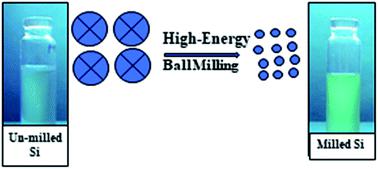当前位置:
X-MOL 学术
›
Faraday Discuss.
›
论文详情
Our official English website, www.x-mol.net, welcomes your
feedback! (Note: you will need to create a separate account there.)
Photophysical properties of ball milled silicon nanostructures.
Faraday Discussions ( IF 3.3 ) Pub Date : 2019-10-22 , DOI: 10.1039/c9fd00105k Ankit Goyal 1 , Menno Demmenie , Chia-Ching Huang , Peter Schall , Katerina Dohnalova
Faraday Discussions ( IF 3.3 ) Pub Date : 2019-10-22 , DOI: 10.1039/c9fd00105k Ankit Goyal 1 , Menno Demmenie , Chia-Ching Huang , Peter Schall , Katerina Dohnalova
Affiliation

|
Luminescent silicon nanocrystals (SiNCs) have attracted scientific interest for their potential use in LEDs, displays, lasers, photovoltaic spectral-shifting filters and for biomedical applications. A lot of efforts have been made to improve the radiative emission rate in SiNCs, mostly using quantum confinement, strain and ligands. Existing methods, however, are not easily upscalable, as they do not provide the high material yield required for industrial applications. Besides, the photoluminescence (PL) efficiency of SiNCs emitting in the visible spectral range also remains very low. Hence, there is a need to develop a low-cost method for high material yield of brightly emitting SiNCs. Theoretically, strain can be used alongside quantum confinement to modify the radiative emission rates and band-gaps. In view of that, high-energy ball milling is a method that can be used to produce large quantities of highly strained SiNCs. In this technique, balls with high kinetic energy collide with the walls of a chamber and other balls, crushing the particles in between, followed by welding, fracture and re-welding phenomena, reducing the particle size and increasing strains in the samples. In this study, we have used high-energy ball milling in an inert gas atmosphere to synthesize SiNCs and study their photophysical properties. The induced accumulation of high strain, quantum confinement and possibly also impurities in the SiNCs resulted in visible light spectrum PL at room temperature. This method is low cost and easily up-scalable to industrial scale.
中文翻译:

球磨硅纳米结构的光物理性质。
发光硅纳米晶体(SiNC)在LED,显示器,激光器,光伏光谱移位滤光片以及生物医学应用中的潜在用途吸引了科学兴趣。为了提高SiNC中的辐射发射率,已经做了很多努力,主要是使用量子限制,应变和配体。然而,现有方法不容易升级,因为它们不能提供工业应用所需的高材料产量。此外,在可见光谱范围内发射的SiNC的光致发光(PL)效率也仍然很低。因此,需要开发一种低成本的方法,以使高亮度发光的SiNC具有高的材料产率。从理论上讲,应变可以与量子限制一起使用,以修改辐射发射速率和带隙。有鉴于此,高能球磨是一种可用于生产大量高应变SiNC的方法。在这种技术中,具有高动能的球与腔室的壁和其他球发生碰撞,将其间的颗粒压碎,然后出现焊接,断裂和重新焊接的现象,从而减小了颗粒尺寸并增加了样品中的应变。在这项研究中,我们已在惰性气体气氛中使用高能球磨合成了SiNC,并研究了它们的光物理性质。SiNCs中高应变,量子限制以及可能还有杂质的诱导积累导致室温下的可见光谱PL。该方法成本低廉,易于升级到工业规模。具有高动能的钢球与腔室的壁和其他钢球相撞,将其间的颗粒压碎,然后出现焊接,断裂和重新焊接的现象,从而减小了颗粒尺寸并增加了样品的应变。在这项研究中,我们已在惰性气体气氛中使用高能球磨合成了SiNC,并研究了它们的光物理性质。SiNCs中高应变,量子限制以及可能还有杂质的诱导积累导致室温下的可见光谱PL。该方法成本低廉,易于升级到工业规模。具有高动能的钢球与腔室的壁和其他钢球相撞,将其间的颗粒压碎,然后出现焊接,断裂和重新焊接的现象,从而减小了颗粒尺寸并增加了样品的应变。在这项研究中,我们已在惰性气体气氛中使用高能球磨合成了SiNC,并研究了它们的光物理性质。SiNCs中高应变,量子限制以及可能还有杂质的诱导积累导致室温下的可见光谱PL。该方法成本低廉,易于升级到工业规模。我们已经在惰性气体气氛中使用了高能球磨来合成SiNC,并研究了它们的光物理性质。SiNCs中高应变,量子限制以及可能还有杂质的诱导积累导致室温下的可见光谱PL。该方法成本低廉,易于升级到工业规模。我们已经在惰性气体气氛中使用高能球磨来合成SiNC,并研究了它们的光物理性质。SiNCs中高应变,量子限制以及可能还有杂质的诱导积累导致室温下的可见光谱PL。该方法成本低廉,易于升级到工业规模。
更新日期:2019-10-22
中文翻译:

球磨硅纳米结构的光物理性质。
发光硅纳米晶体(SiNC)在LED,显示器,激光器,光伏光谱移位滤光片以及生物医学应用中的潜在用途吸引了科学兴趣。为了提高SiNC中的辐射发射率,已经做了很多努力,主要是使用量子限制,应变和配体。然而,现有方法不容易升级,因为它们不能提供工业应用所需的高材料产量。此外,在可见光谱范围内发射的SiNC的光致发光(PL)效率也仍然很低。因此,需要开发一种低成本的方法,以使高亮度发光的SiNC具有高的材料产率。从理论上讲,应变可以与量子限制一起使用,以修改辐射发射速率和带隙。有鉴于此,高能球磨是一种可用于生产大量高应变SiNC的方法。在这种技术中,具有高动能的球与腔室的壁和其他球发生碰撞,将其间的颗粒压碎,然后出现焊接,断裂和重新焊接的现象,从而减小了颗粒尺寸并增加了样品中的应变。在这项研究中,我们已在惰性气体气氛中使用高能球磨合成了SiNC,并研究了它们的光物理性质。SiNCs中高应变,量子限制以及可能还有杂质的诱导积累导致室温下的可见光谱PL。该方法成本低廉,易于升级到工业规模。具有高动能的钢球与腔室的壁和其他钢球相撞,将其间的颗粒压碎,然后出现焊接,断裂和重新焊接的现象,从而减小了颗粒尺寸并增加了样品的应变。在这项研究中,我们已在惰性气体气氛中使用高能球磨合成了SiNC,并研究了它们的光物理性质。SiNCs中高应变,量子限制以及可能还有杂质的诱导积累导致室温下的可见光谱PL。该方法成本低廉,易于升级到工业规模。具有高动能的钢球与腔室的壁和其他钢球相撞,将其间的颗粒压碎,然后出现焊接,断裂和重新焊接的现象,从而减小了颗粒尺寸并增加了样品的应变。在这项研究中,我们已在惰性气体气氛中使用高能球磨合成了SiNC,并研究了它们的光物理性质。SiNCs中高应变,量子限制以及可能还有杂质的诱导积累导致室温下的可见光谱PL。该方法成本低廉,易于升级到工业规模。我们已经在惰性气体气氛中使用了高能球磨来合成SiNC,并研究了它们的光物理性质。SiNCs中高应变,量子限制以及可能还有杂质的诱导积累导致室温下的可见光谱PL。该方法成本低廉,易于升级到工业规模。我们已经在惰性气体气氛中使用高能球磨来合成SiNC,并研究了它们的光物理性质。SiNCs中高应变,量子限制以及可能还有杂质的诱导积累导致室温下的可见光谱PL。该方法成本低廉,易于升级到工业规模。









































 京公网安备 11010802027423号
京公网安备 11010802027423号